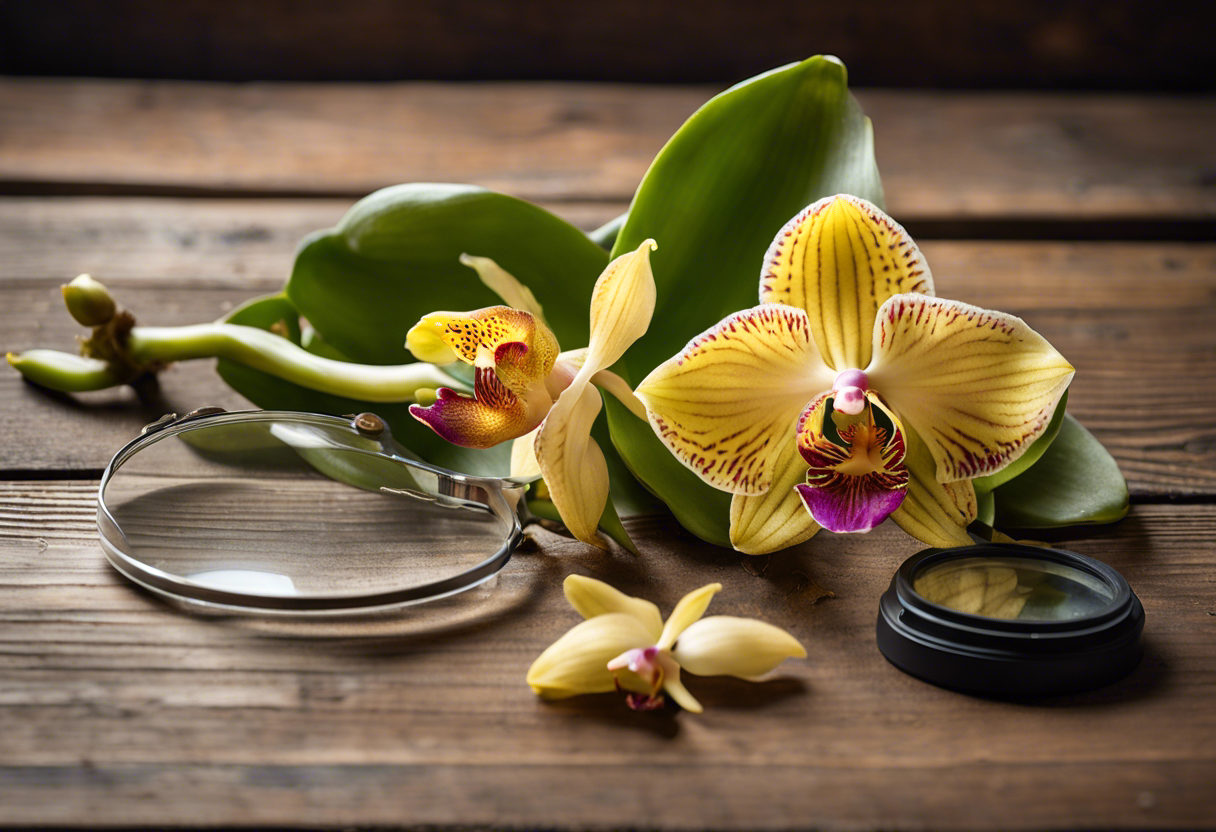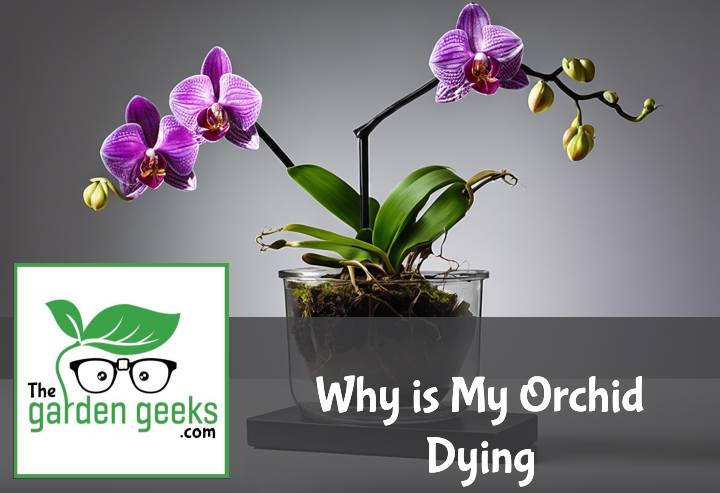Ever looked at your beloved orchid and thought, “Why is My Orchid Dying“:https://en.wikipedia.org/wiki/Orchid_(album)? We’ve all been there, trust me. One day it’s blooming with vibrant colors, and the next thing you know, it’s wilting faster than a vampire in sunlight.
Don’t fret though! I’m here to guide you through the jungle of orchid care. Together we’ll uncover the reasons behind your plant’s sad face and explore eight practical solutions that will have it grinning ear-to-ear again in no time. So buckle up, green thumb warriors – let’s save an orchid today!
Key Takeaways
- Orchids may be dying due to overwatering, under-watering, insufficient light, temperature extremes, or poor air circulation.
- Overwatering can lead to root rot; let the orchid dry out between waterings.
- Insufficient light can stunt growth; provide bright but indirect sunlight.
- Extreme temperatures can cause stress; maintain a temperature of 60-75°F.
- Poor air circulation can promote disease; ensure good ventilation.
- Repotting in fresh medium and using a balanced fertilizer can also help revive your orchid.

Understanding Orchid Health
To keep your orchids vibrant and flourishing, it’s crucial to understand orchid health. This involves recognizing the signs of a healthy orchid and identifying when things go south. With proper orchid care tips, you’ll be maintaining orchids like a pro in no time!
Recognizing Healthy Orchid Signs
So, what does a healthy orchid look like? Well, healthy orchid signs are pretty straightforward. Your orchid should have firm, bright green leaves – that’s a sign of a flourishing orchid.
The flowers? They should be perky and vibrant, not droopy or faded. And let’s not forget about the roots! Healthy roots are typically white or green and firm to the touch.
Identifying Unhealthy Orchid Signs
Now on to the less fun part – identifying unhealthy or dying orchids. If you’re asking yourself “Why is My Orchid Dying?”, there are some telltale signs to look out for.
First off, wilting or yellowing leaves can indicate an issue with your plant’s health. Similarly, if your once vibrant flowers start drooping or falling off prematurely, that’s another red flag.
And remember those healthy roots we talked about earlier? If they start turning brown or mushy, it might be time to step up your orchid care game!
Common Reasons Why Your Orchid May Be Dying

If you’re wondering, “Why is my orchid dying?”, there could be a few common orchid problems at play. It’s not always easy to pinpoint the exact reasons for orchid death, but let’s start with some usual suspects: watering, light exposure, temperature conditions, and air circulation/humidity.
Inadequate Watering Practices
Ah, watering! The most common of all orchid care mistakes. Overwatering or underwatering your plant can lead to a sad, wilting orchid.
Overwatered orchids often display symptoms like yellow leaves and root rot. On the other hand, underwatered orchids may have wrinkled leaves and dry roots.
The key here is balance! You need to find the sweet spot of proper watering for orchids, which depends on factors like your environment and the type of orchid you have.
Incorrect Light Exposure
Next up on our list of culprits is incorrect light exposure. Orchids are Goldilocks when it comes to sunlight – they don’t want too much or too little!
If your plant is getting too much light, it might show signs of sunburn like yellow or brown patches on the leaves. Conversely, insufficient light can lead to dark green leaves and lack of blooming.
Adjusting light exposure for your orchid isn’t rocket science – just move it closer or further from the window until you find its happy place!
Unsuitable Temperature Conditions
Temperature plays a huge role in keeping your orchid alive and kicking. Most varieties prefer a temperature range between 60-80°F during the day and a slight drop at night.
Extreme temperatures can cause stress in your plant leading to leaf drop or bud blast. Always keep an eye out for these signs!
Maintaining optimal temperature for your orchid might require some trial and error, but hey, nobody said being an orchid parent was easy!
Poor Air Circulation and Humidity Levels
Last but not least, let’s talk about air circulation and humidity. Orchids are tropical plants that love a good breeze and high humidity.
Poor air circulation can lead to diseases like root rot or fungal infections. Similarly, low humidity levels can cause your orchid to dry out.
To improve conditions, consider using a fan for better air circulation or a humidifier to increase moisture levels. Remember – happy orchid, happy life!

Solutions to Revive Your Dying Orchid
Don’t fret if you’re wondering, “Why is My Orchid Dying?” There are several orchid revival solutions that can help bring your plant back to life. Let’s dive into them!
Adjusting Watering Techniques
The first thing to consider when reviving dying orchids is the watering technique. Believe it or not, overwatering and underwatering are common culprits behind a wilting orchid.
To save my orchid, you might need to adjust your watering habits. Overwatered orchids can suffer from root rot, while underwatered ones may dry out and wilt. The key is finding a balance.
Remember, proper watering for orchids involves soaking the roots and then allowing them to dry before the next watering session. This mimics their natural rainforest habitat and keeps them happy!
Modifying Light Exposure
Next up on our list of orchid care tips is light exposure. Just like us humans, orchids need sunlight to thrive – but not too much!
Adjusting light for orchids can be tricky. Too much direct sunlight can scorch their leaves, while too little can stunt their growth.
Try placing your plant in a bright room with indirect sunlight for optimal sunlight exposure for orchids. You’ll notice a difference in no time!
Regulating Temperature Conditions
Temperature plays a crucial role in an orchid’s health too! If you’re still asking “Why is My Orchid Dying?”, check your thermostat.
Orchids prefer moderate temperatures – not too hot, not too cold. So regulating temperature for orchids is essential for their survival.
Maintaining an ideal temperature for growing orchids usually means keeping them in a range of 60-75 degrees Fahrenheit during the day and slightly cooler at night.
Improving Air Circulation and Humidity
Last but not least, let’s talk about air circulation and humidity. These two factors are often overlooked but are vital for orchid recovery methods.
Orchids thrive in environments with good air circulation and high humidity. So improving these conditions can significantly help your plant.
Try placing a small fan near your orchid to increase air circulation, and consider using a humidifier to maintain optimal humidity levels for growing orchids. Your orchid will thank you!
Preventive Measures for Future Orchid Health
Let’s talk about preventive measures. They’re like the superheroes of orchid care, swooping in to save the day before any villainous diseases can take hold. Trust me, your orchids will thank you!
Regular Monitoring of Plant Health
So, how do we keep our orchids from asking, “Why is My Orchid Dying?” Well, it all starts with regular monitoring. It’s like giving your orchid a regular health check-up. You wouldn’t skip your own doctor’s appointment, would you?
Keep an eye out for any signs of orchid disease or stress. If your orchid starts looking a bit down in the dumps (or leaves), it might be trying to tell you something.
Proper Feeding and Fertilization
Next up on our superhero roster is proper feeding and fertilization. Think of this as the superfood smoothie for your orchids – packed full of all the good stuff they need for healthy growth.
But remember, overfeeding is just as bad as underfeeding! Too much love can be harmful too. So find that Goldilocks zone when it comes to orchid feeding and fertilization.
And voila! With these preventive measures in place, you’ll be well on your way to preventing any future cries of “Why is My Orchid Dying?” from your green friends.

To Wrap Up
Just like a detective, you’ve been sleuthing through the clues of “Why is My Orchid Dying”. Now, armed with your newfound knowledge, it’s time to bring your orchid back from the brink. Remember, treat your orchid like a pampered pet – give it just the right amount of attention and care.
Don’t let your green thumb turn into a thumb of doom! Keep these 8 solutions in mind and let’s turn that wilting wonder into an orchid oasis. For more tips, visit Why is My Orchid Dying.


